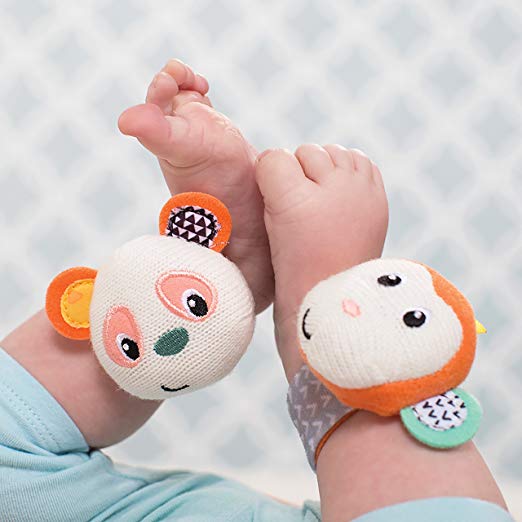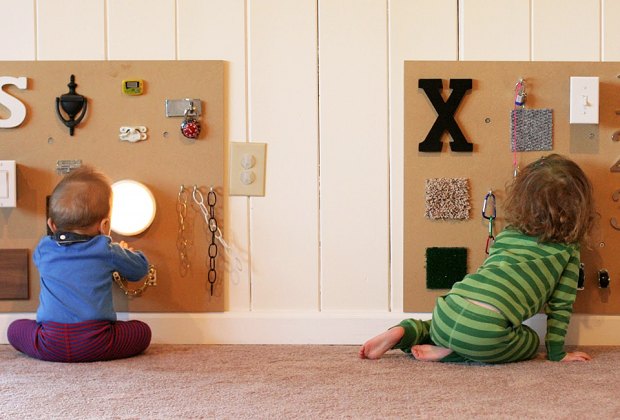10 Sensory Activities for Infants (0 – 12 Months)
What’s inside this article: 10 sensory activities for infants ages 0-12 months to encourage healthy sensory development throughout baby’s first year.
Disclaimer: This post contains affiliate links.
Sensory information is the basis of all learning that’s why it only makes sense for new parents to engage in sensory activities for infants with their new bundle.
During a baby’s first year, their brain is forming trillions of neural pathways. These neural pathways are what ultimately shape behavior, memories, emotions, intelligence, and later, executive functions.
This is why it’s essential to child development that babies engage in regular, stimulating, multisensory experiences. These sensory activities for infants strengthen the connections between brain cells, strengthening neural pathways, and affecting your baby’s development.
Sensory Development
Sensory development begins in the womb.
When babies are born, their hearing, touch, and smell are fully developed. However, newborns can’t yet focus on objects unless they are close to them. They can only distinguish contrasting colors and shapes.
By 6 months though, your baby can use their sight to distinguish even small details. They’ll notice every crumb on the floor, and try to put it in their mouth, too.
They’re using their senses to explore and learn about their world.
By engaging in sensory play with your baby, you’re enhancing their learning and encouraging healthy sensory development. Early sensory play influences everything, including:
Sensory Activities for Infants

Skin to Skin
Baby’s sense of touch, known as the tactile system, is fully developed at birth. That’s why skin-to-skin is such an important sensory experience for newborns.
Since sensory information is the basis of all learning – this experience helps your baby learn that they can trust you, feel safe and secure. Skin to skin helps calm your baby, relieves stress, stabilizes temperature and breathing, and regulates blood sugar.
This is one of the very first sensory experiences your baby has. All the smells, textures, touches, and sounds your baby experiences while laying on your chest helps their brain develop and form neural pathways.
Sing to your baby
Babies can hear in the womb.
So they’ll recognize familiar voices, like moms, from birth. Singing is a way to connect with your baby.
Babies and children do best when they grow up in a consistent and predictable environment. Having songs for different parts of the day can help establish your baby’s routine and guide them through transitions.
Establishing routines and having a consistent signal for transitions from birth can help as kids approach their toddler years when it’s more common for them to struggle with or resist transitions.
Trying having a set song for:
Narrate your day
As you know, babies recognize, and love, the sound of your voice. So, narrating your day provides your baby with comforting auditory input and also helps form critical connections in the brain that will influence early language development.
It’s easy to do. Just talk out loud about everything you’re doing as you do it.
Your baby’s brain will continue to make connections. They will start to pick up on patterns and routines and names for common household objects.
Noise Making Toys
Rattles, maracas, squeaky toys – these are all great sensory toys for infants.
They help develop gross motor skills. All that grasping and rattling gives your baby’s gross motor skills a great workout!
Plus the encourage healthy sensory development: The variety of colors, textures, and fun rattle sounds help stimulate your baby’s developing senses.
Fisher-Price carries a large range of noise-making toys.
If your baby hasn’t yet developed motor control to grasp these toys, you can also give them these adorable wrist and ankle rattles. Your little one will get to hear different noises as they wiggle and kick their arms and legs.

Finger Painting
Once your baby is able to sit up and gains some motor control, you can start introducing them to fun tactile activities, like finger painting.
You can also do handprint and footprint crafts with paint when your baby is younger. But finger painting is a great way to let your baby start exploring their senses on their own.
Use a large roll of paper and roll it out on the floor so your baby can get as messy as they like. Then, leave the paint out on a tray or paper plate so your baby has an open invitation to explore.
I know babies love putting everything in their mouths so try this easy, edible finger paint recipe.
Messy Play Sensory Bins
There are so many different, baby-safe items you can use to create messy sensory bins. The benefit is that your baby can experience many different types of tactile input by feelings various textures, consistencies, temperatures, etc.
You’ll get to know your child’s preferences as well. Some babies like to get messy and some don’t. Is there a texture your baby avoids? Something they like?
You’ll get to know these things by trying out a variety of sensory bin fillers with them.
Some ideas for your sensory bins:
Textured Books
Textured books are the perfect way to interact with your baby and engage the senses together. This helps your baby learn and develop early language skills.
Reading with your baby is also a great bonding experience and there are many other benefits of reading to your baby, too.
You can get a lot of unique textured board books on Amazon. My favorites are from the “Never touch a …” collection. They have a variety of books, such as, “Never touch a dinosaur”, “Never touch a porcupine”, and “Never touch a dragon”.
Sensory Board
A sensory board allows babies to explore different textures and objects, practice fine motor skills, and keep busy. These boards are entertaining for toddlers as well.
You can make them yourself and most of the objects you add to the board can be found at the dollar store so it’s an inexpensive DIY toy for your baby.
Add things to the board like light switches, bells, zippers, buttons, a mirror, etc.
Asia Citro from Fun at Home with Kids provides full instructions about how to make a sensory board on her blog. You can read her guide here.

Lights in a Jar
Babies love lights from a very young age, as well as contrasting colors. It’s calming and mesmerizing. You can make your baby their very own jar of lights to hold their gaze.
All you need is:
Just stick the lights into the jar and put on the lid. Depending on your baby’s age and how the lights turn on and off, you may want to glue the lid shut.
Baby Wear
Not only is babywearing a way to be close to your baby, and bond with them, it’s also a good sensory activity for infants.
The proprioceptive system is the sense of body awareness and this takes some time to develop (think about when babies first find their feet, for example – they previously didn’t have awareness that they had body parts they can’t see).
Pressure helps provide proprioceptive input and having your baby snuggly wrapped or in a carrier provides comforting pressure to their bodies.
The vestibular system is the sense of movement. It plays a role in the development of motor skills, balance, coordination, and affects self-regulation.
As your baby moves with you while you babywear, the movement stimulates their vestibular system and allows them to experience movement in a calming way, similar to how they felt in the womb.
I used a Tula baby carrier with my children because of the functionality compared to other carriers. There are multiple ways to carry your baby and each position provides a natural, ergonomic position best for comfortable carrying that promotes healthy hip and spine development for baby.
Sensory stimulation is an important part of infant brain development. Engaging in sensory activities for infants can aid cognitive development for your child during their first year – and onwards.


